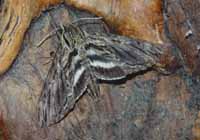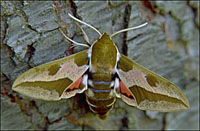Sphinginae subfamily
Sphingini tribe:
 |
Ceratomia amyntor, Elm Sphinx; Four-horned Sphinx:
The upperside of the forewing is brown with dark brown and white markings including a white costal area near the wing base, dark streaks along the veins, and a
white spot in the cell. Larvae feed on Elm (Ulmus), birch (Betula), basswood (Tilia), and cherry (Prunus). |
 |
Ceratomia undulosa, Waved Sphinx.
Pale brownish gray (occasionally dark) with wavy black and white lines and a black-outlined white cell spot. HW gray with diffuse darker bands.
Some individuals are very dark, almost black, and others are light yellowish brown.
|
 |
Lintneria eremitus, Hermit Sphinx:
The upperside of the forewing is gray-brown with wavy lines, black dashes, and one or two small white spots near the center of the costa. |
 |
Lapara bombycoides, Northern Pine Sphinx.
The upperside of the forewing is gray with heavy black bands. The upperside of the hindwing is brownish gray with no markings.
The underside is rather plain.
|
 |
Manduca quinquemaculatus, Five-spotted Hawkmoth.
Abdomen usually has five but sometimes six pairs of yellow bands. Forewing is blurry brown and gray. If
you grow tomatoes, you might encounter it. |
 |
Sphinx canadensis, Sphinx canadensis, the Canadian Sphinx, is not common, and is not
often reported anywhere. The absence of the white spot on each forewing and the more brownish coloration serve to separate canadensis from S. poecila.
Larval hosts are white ash (Fraxinus americana) and blueberry (Vaccinium). |
 |
Sphinx chersis, Northern Ash Sphinx; Great Ash Sphinx: Soft
dark gray to blue-gray with a series of black dashes, one of which reaches the wing tip. Larval hosts are ash, lilac, privet, cherry, and quaking aspen.
|
 |
Sphinx drupiferarum, Wild Cherry Sphinx.
Dull slate grey with considerable light grey scaling in broad band along costa about 3/4 of distance from body toward apex. Median lines:
black, thin. Wavy, diffuse dark subterminal line, inwardly bordered by white, and whitish bar in terminal area, paralleling outer margin.
|
 |
Sphinx gordius, Apple Sphinx: Note the pm line, absent in Sphinx poecila which generally flies
more to the north.
|
 |
The lower forewings are predominantly brownish-yellow with a fairly wide dark bar along the inner margin. At rest the wings hug the body,
giving the moth a long slender look. |
 |
Sphinx luscitiosa , Canadian Sphinx or
Clemen's Sphinx: Fw: yellowish gray in males; pale gray with a faint yellow tint in females.
Dark border on outer margin widens as it approaches inner margin. Hw deep yellow in males, pale yellow in females; both with wide black border.
|
 |
If you have blueberries in the woods, then you might have the Poecila
Sphinx. They are pretty common here on Prince Edward Island, but
don't fly too far west of Wisconsin. |
Smerinthini Tribe:
 |
Amorpha juglandis, the Walnut Sphinx.
This moth is also fairly widely reported to the east and south and might be present.
This is the first Sphinx species I reared as a boy in New Jersey. See the file for the female; she is different. |
 |
This moth is also found in Canada. Moths have very heavy bodies. Larvae eat poplar and willow. |
 |
Paonias excaecata, the Blinded Sphinx.
Named for the dull grey-blue spot in the hindwing, this moth has a very wide distribution.
Note very irregular forewing outer margin. |
 |
Paonias myops, the Small-eyed Sphinx.
Named for the small eye-spot in the hindwing, this moth has a very wide distribution.
The forewing outer margin is not nearly as irregular as in excaecata. |
 |
Smerinthus cerisyi, Cerisyi's Sphinx.
Smerinthus cerisyi is found in the southern regions of all Canadian provinces and in northern border states. The One-eyed Sphinx is also found along
the U.S. west coast, eastward to the Rockies. Note: whitish subapical arc does not return to outer margin. |
 |
Smerinthus jamaicensis, Twin-spotted Sphinx.
Closely resembles Smerinthus cerisyi, but jamaicensis is much smaller with larger blue patches on more
vibrant, deeper purple in lower wings. Note: whitish subapical arc returns completely to outer margin, forming letter "c". |
Macroglossinae subfamily
Dilophonotini tribe:
 |
Hemaris diffinis, the Snowberry Clearwing or Bumblebee Moth.
This moth is widely distributed and is found in Cook County. Note black legs and black on abdomen. |
 |
Hemaris gracilis, The Slender Clearwing or Graceful Clearwing:
This day flier is not commonly reported. Note red and red on dorsal surface of abdomen. |
 |
Hemaris thysbe, the Hummingbird Clearwing.
It is not difficult to see why many gardeners would mistake an Hemaris thysbe moth for a small hummingbird as it hovers, sipping nectar from flowers through a
long feeding tube. Note off-white legs. |
See Hemaris comparisons.
Macroglossini tribe:
 |
Amphion floridensis, the Nessus Sphinix:
This day flier is widely distributed. If you have Virginia Creeper, you probably have the Nessus Sphinx. Two bright, distinct, narrow yellow
bands are often visible on the abdomen. |
 |
Darapsa choerilus, Azalea Sphinx.
Orangey brown forewings. The lower wings of this hawkmoth are a solid brownish-orange, matching the body colour.
You will often see this species listed as Darapsa pholus, especially in older literature. |
 |
Darapsa myron, Virginia Creeper Sphinx; Grapevine Sphinx: If you have foodplants indicated in
common names, you might have this species nearby. Lower wings orange.
The inner edge of dark postmedian band is outwardly quite convex. Some individuals are orangey-brown.
|
 |
Hyles euphorbiae, Spurge Hawk Moth. The body is light brown with various white and dark brown
markings, while the wings have a conspicuous tan, brown, and pink or red color pattern.
|
 |
Hyles gallii, Bedstraw Hawk Moth or Gallium Sphinx.
Relatively thick, very irregular, transverse, tan bar on dark brown forewing. |
 |
Hyles lineata, the White-lined Sphinx.
This species is not officially recorded in Cook County. It is a strong migrator from the south, and probably appears
late summer or early fall. |
|
Enjoy some of nature's wonderments, giant silk moth cocoons.
These cocoons are for sale winter and fall. Beautiful Saturniidae moths will emerge the following spring and summer.
Read Actias luna rearing article. Additional online help available.
Use your browser "Back" button to return to the previous page.
This page is brought to you by
Bill Oehlke and the
WLSS. Pages are on space rented from Bizland. If you would like
to become a "Patron of the Sphingidae Site", contact Bill.
Please send sightings/images to Bill. I will do my best to respond to requests for identification help.
 | 
Show appreciation for this site by clicking on flashing butterfly to the left.
The link will take you to a page with links to many insect sites. |
This website has been created and is maintained by Bill Oehlke without government or institutional financial assistance. All expenses, ie., text reference
support material, webspace rental from Bizland, computer repairs/replacements, backups systems, software for image adjustments (Adobe Photoshop; L-View),
ftp software, anti-virus protection, scanner, etc. are my own.
I very much appreciate all the many images that have been sent to me, or of which I have been granted permission to copy and post from other websites.
All images on this site remain the property of respective photographers.
If you would like to contribute to the maintenance of this website by sending a contribution to
Bill Oehlke
Box 476
155 Peardon Road
Montague, Prince Edward Island, C0A1R0
Canada
your donation would be much appreciated and would be used for
1) paying for webspace rental;
2) paying for computer maintenance and software upgrades;
3) purchases of additional text reference material (journals and books) in anticipation of expanding the site to a worldwide Sphingidae site;
4) helping to pay my daughter's tuition (completed spring 2013); with anything left over going to humanitarian aid.
If you are mailing a check from USA, please use $1.10 postage ($1.25 is 2019 rate so check with post office as rates seem to be rising annually).
Donations can also be made through Paypal via the button below.
|




























